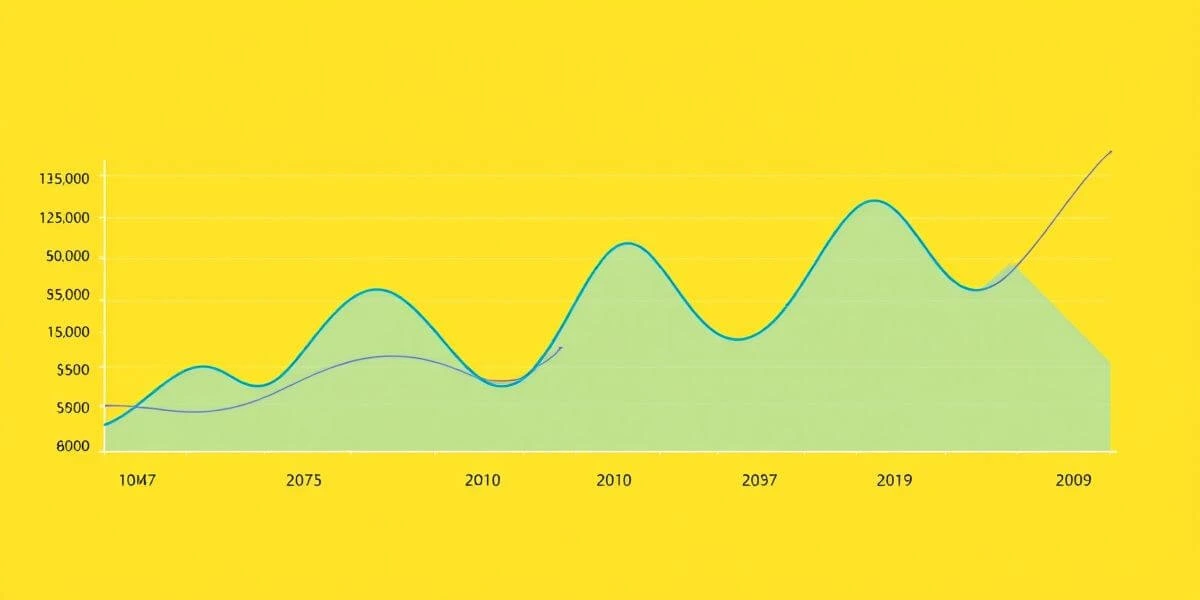Achieving long-term financial success is a goal shared by many, but the path to achieving it can seem complex and intimidating. In today’s dynamic economic landscape, employing sound investment strategies is more important than ever. Whether you’re a seasoned investor or just beginning your financial journey, understanding and applying a variety of investment strategies can help you build a resilient portfolio that can withstand market volatility and maximize returns over time.
In this comprehensive guide, we explore five of the most effective investment strategies for long-term financial success. Drawing on concepts such as diversification, dollar-cost averaging, index fund investing, dividend investing, and real estate investing, this article will provide you with practical insights and actionable advice to enhance your wealth-building journey. We will also discuss related terms such as asset allocation, risk management, and compounding, and reference influential companies and experts such as Warren Buffett, Vanguard, and Fidelity to underscore our strategies.
1. Diversification: The Foundation of a Resilient Portfolio

One of the most fundamental principles of investing is diversification. By spreading your investments across different asset classes, sectors, and geographic regions, you reduce the overall risk in your portfolio. Diversification isn’t just about owning different stocks; it’s about strategically balancing your portfolio to mitigate potential losses and take advantage of different growth opportunities.
Understanding Diversification
The strategy of diversifying investments across asset types and markets reduces your exposure to individual investment risks. It is based on the idea that a portfolio composed of different types of investments will, on average, have higher returns and lower risk than any individual investment in the portfolio.
Investors achieve diversification by investing in a mix of stocks, bonds, real estate, and even alternative investments such as commodities. That way, if one asset class underperforms, others can perform well and offset the loss. For example, during an economic downturn, bonds and dividend-paying stocks may provide more stability than riskier assets such as growth stocks.
In addition, diversification is not just about asset classes; geographic and sector diversification can also play an important role. Spreading investments across different countries and sectors can help protect your portfolio when certain regions or industries face economic challenges.
Benefits of a Diversified Portfolio
The advantages of a diversified portfolio extend far beyond mere risk reduction. Here are some key benefits:
- Risk Mitigation: Diversification helps protect against significant losses because poor performance in one area can be offset by strong performance in another. This is crucial when market conditions change unexpectedly.
- Smoother Returns: With diversified investments, you are more likely to experience steady growth over time. This approach avoids the extreme ups and downs that might occur with a concentrated portfolio.
- Exposure to Growth Opportunities: Diversification allows you to capture growth from different areas of the economy. Whether it’s emerging markets, technology sectors, or even sustainable investments, having exposure to a wide range of assets can lead to a more robust portfolio.
- Improved Capital Preservation: By spreading risk, diversification helps preserve your capital, which is especially important during periods of high market volatility or economic uncertainty.
Implementing Diversification in Your Investment Strategy
Putting diversification into practice begins with a thorough analysis of your current portfolio and understanding your risk tolerance. Here are several steps to achieve effective diversification:
- Assess Your Asset Allocation: Start by evaluating the mix of assets in your portfolio. A balanced allocation might include stocks, fixed-income securities, and real estate. Consider using financial tools or consulting with a financial advisor to determine the ideal asset mix for your long-term goals.
- Include Various Sectors and Industries: Avoid over-investing in a single sector. For instance, if you’re heavily invested in technology stocks, consider adding positions in healthcare, consumer goods, or industrial sectors.
- Explore International Markets: Global diversification can protect your portfolio from domestic market volatility. Consider investing in international index funds or ETFs that provide exposure to emerging and developed markets.
- Consider Alternative Investments: Assets like real estate, commodities, or even peer-to-peer lending can add another layer of diversification. These alternatives often have low correlation with traditional stocks and bonds.
Common Pitfalls to Avoid with Diversification
While diversification is essential, it is important to avoid common pitfalls that can undermine its effectiveness:
- Over-Diversification: Sometimes referred to as “diversification,” owning too many investments can dilute potential returns and make portfolio management unwieldy. Focus on quality over quantity.
- Neglecting Regular Rebalancing: Market movements can lead to an imbalanced portfolio over time. Regular rebalancing ensures that your investments remain aligned with your strategic asset allocation.
- Ignoring Costs: Diversification should not come at an exorbitant cost. High fees and transaction costs can undermine the benefits of a diversified portfolio. Look for low-cost index funds and ETFs to keep expenses low.
- Misunderstanding Correlation: Not all asset classes react to market events in the same way. It’s crucial to understand the correlation between different investments. Assets with a low or negative correlation provide better diversification benefits than those that move in tandem.
By understanding and effectively implementing diversification, you lay the groundwork for a resilient investment strategy that can weather market storms and deliver steady, long-term growth.
2. Dollar-Cost Averaging: Navigating Market Volatility
Dollar-cost averaging (DCA) is a disciplined investment approach designed to reduce the impact of volatility on your overall portfolio. By investing a fixed amount of money at regular intervals, regardless of market conditions, you can smooth out the purchase price over time and avoid the pitfalls of trying to time the market.
What is Dollar-Cost Averaging?
Dollar-cost averaging involves investing a set amount of money into a particular asset or portfolio on a regular schedule, such as monthly or quarterly. This method results in purchasing more shares when prices are low and fewer shares when prices are high, thereby lowering the average cost per share over time.
This strategy is especially effective in volatile markets, where prices can swing dramatically. Instead of risking a large lump sum investment at an inopportune time, DCA allows you to build your position gradually. It’s a simple and accessible strategy that doesn’t require complex market predictions or timing.
How Dollar-Cost Averaging Mitigates Risk
One of the primary benefits of DCA is its risk mitigation. Here’s how dollar-cost averaging works to reduce investment risk:
- Reduces Timing Risk: By investing consistently, you avoid the challenge of trying to predict market highs and lows. This is especially important in uncertain markets where timing the market can lead to significant losses.
- Smooths Out Market Fluctuations: Regular investments mean that you buy shares at varying price points. Over time, this helps balance out the cost of your investments, protecting you from short-term market volatility.
- Encourages a Long-Term Perspective: DCA encourages a disciplined, long-term approach to investing. It shifts your focus from immediate market conditions to the benefits of steady, cumulative growth over time.
- Builds Financial Discipline: A commitment to investing regularly reinforces good financial habits. This consistency not only builds wealth but also instills a sense of financial discipline, which is essential for long-term success.
Strategies for Implementing Dollar-Cost Averaging
To effectively implement dollar-cost averaging into your investment strategy, consider the following practical steps:
- Set a Regular Investment Schedule: Decide on a fixed amount that you can invest on a regular basis, such as monthly or quarterly. Automating this process can help you stay disciplined through periods of market uncertainty.
- Choose Investment Vehicles Wisely: Dollar-cost averaging works well with mutual funds, index funds, and ETFs. These investment vehicles often allow for regular, automatic investments with low fees.
- Monitor and Adjust: While DCA is designed to be a set-and-forget strategy, it’s important to review your portfolio regularly. Adjust your contributions as your financial situation or market conditions change.
- Stay Focused on Long-Term Goals: It can be tempting to deviate from your plan during market downturns. However, maintaining a long-term focus and sticking to your investment plan is key to realizing the benefits of dollar-cost averaging.
Real-World Examples and Case Studies
Consider the example of a young professional who commits to investing $500 every month into an index fund that tracks the S&P 500. Over the course of a decade, this disciplined approach resulted in purchasing shares at various market prices. During market dips, the investor buys more shares for the same dollar amount, and during market highs, fewer shares are purchased. Over time, this averages out to a lower cost per share than if the investor had tried to time the market perfectly.
Historical data supports the effectiveness of dollar-cost averaging. For example, during the 2008 financial crisis, many investors who continued their regular investments saw significant long-term growth once the market recovered. Their commitment to DCA allowed them to capitalize on lower prices during the downturn and benefit from the subsequent market rebound.
By embracing dollar-cost averaging, investors can confidently navigate market volatility and ensure that their portfolios grow steadily over time without the stress of market timing.
3. Index Fund Investing: Embracing Passive Management

Index fund investing has gained popularity as a straightforward, low-cost strategy that offers investors exposure to a broad market without the need for active management. Passive investing with index funds is built on the idea that it’s challenging to consistently outperform the market, and therefore, capturing the market’s average returns is a prudent strategy for long-term wealth building.
The Rise of Index Funds in Modern Investing
Index funds have revolutionized the investment world over the past few decades. Developed by firms like Vanguard and popularized by influential investors such as Warren Buffett, index funds allow investors to track the performance of an entire market or a specific sector with minimal fees. Instead of trying to pick winning stocks, investors buy a slice of the market, ensuring they participate in the overall growth of the economy.
The evolution of index funds can be attributed to the growing recognition that actively managed funds often fail to outperform their benchmarks after fees and expenses are factored in. With the advent of low-cost index funds, investors can now achieve diversification and steady growth without the need for constant portfolio management.
Advantages of Passive Investing with Index Funds
Investing in index funds offers numerous benefits, making them an attractive option for both novice and experienced investors:
- Low Costs: Index funds typically have lower management fees than actively managed funds, which can significantly improve long-term returns.
- Broad Diversification: By tracking an entire market index, such as the S&P 500 or the Dow Jones Industrial Average, investors gain exposure to hundreds of companies across various sectors.
- Simplicity and Transparency: Index funds are easy to understand and manage. Their performance closely mirrors that of the underlying index, providing a clear benchmark for success.
- Consistent Performance: Over the long term, index funds have consistently delivered market-average returns, making them a reliable component of a diversified portfolio.
Choosing the Right Index Funds for Your Portfolio
When selecting index funds, it is important to consider several factors to ensure they align with your long-term financial goals:
- Expense Ratios: Even small differences in fees can have a significant impact on long-term returns. Look for funds with low expense ratios to maximize your growth potential.
- Tracking Accuracy: Evaluate how closely the index fund tracks its benchmark. Funds that closely replicate the performance of their underlying index are generally more desirable.
- Fund Size and Liquidity: Larger funds typically offer better liquidity and lower transaction costs. They also tend to be more stable during periods of market volatility.
- Investment Objectives: Consider your investment goals and risk tolerance. Whether you’re looking for aggressive growth or steady income, choose an index fund that aligns with your overall strategy.
Tools and Resources for Index Fund Investors
Modern technology has made it easier than ever to research, monitor, and manage index fund investments. These resources and tools may be useful:
- Financial News Platforms: Websites like Bloomberg, CNBC, and Reuters provide up-to-date market news and analysis that can help you stay informed.
- Investment Calculators: Use online calculators to project potential returns and assess the impact of fees over time.
- Brokerage Platforms: Many online brokerages offer low-cost or even commission-free trading options, making it easier to invest in index funds.
- Robo-Advisors: For those who prefer a hands-off approach, robo-advisors can automatically invest in a diversified portfolio of index funds based on your risk profile and financial goals.
By investing in index funds, you are adopting a passive management strategy that is both cost-effective and aligned with broader market trends. This approach not only minimizes risk, but also lays the foundation for long-term growth through steady compounding.
4. Dividend Investing: Earning Passive Income for the Future

Dividend investing focuses on building a portfolio of stocks that pay regular dividends. This strategy not only provides the potential for capital appreciation but also generates a steady stream of income that can be reinvested or used to cover living expenses. For long-term investors, dividend stocks offer the dual benefits of growth and income stability.
The Basics of Dividend Investing
At its core, dividend investing involves buying stocks that distribute a portion of their earnings to shareholders in the form of dividends. Companies with a strong history of paying dividends are often well-established, financially stable, and committed to returning value to their investors.
Dividends can be paid out quarterly, semi-annually, or annually, and the income generated can be reinvested to purchase additional shares-a strategy known as dividend reinvestment. Over time, this reinvestment can lead to the powerful effects of compound interest, significantly boosting your overall returns.
How Dividends Contribute to Long-Term Wealth
Several key factors make dividend investing particularly attractive for long-term wealth accumulation:
- Steady Income Stream: Dividends provide a reliable source of passive income that can help smooth out the irregularities of capital gains. This income can be especially valuable during retirement or periods of economic uncertainty.
- Compounding Returns: Reinvested dividends buy more shares, which in turn generate their own dividends, creating a compounding cycle that accelerates wealth accumulation over time.
- Market Downside Protection: Dividend-paying companies tend to be more established and financially secure. Their regular dividend payments can cushion the impact of market downturns.
- Tax Advantages: In many jurisdictions, qualified dividends may be taxed at a lower rate than ordinary income, providing an additional incentive for long-term investors.
Evaluating Dividend Stocks: Key Metrics to Consider
Successful dividend investing requires careful analysis and evaluation of potential stocks. Here are some key metrics and factors to consider when selecting dividend-paying companies:
- Dividend Yield: This metric measures the annual dividend payment relative to the stock’s current price. A higher yield can be attractive, but it should be balanced with the company’s overall financial health.
- Dividend Growth Rate: Look for companies with a history of consistently increasing their dividends. A steady growth rate indicates strong underlying financial performance and a commitment to returning value to shareholders.
- Payout Ratio: This ratio indicates what percentage of a company’s earnings are paid out as dividends. A lower payout ratio may indicate that a company has room to increase its dividend payments in the future.
- Financial Stability: In addition to dividend metrics, evaluate the company’s overall financial health by examining factors such as revenue growth, debt levels, and profitability.
Strategies for Reinvesting Dividends
Maximizing the benefits of dividend investing often means reinvesting dividends rather than cashing them out. Here’s how to reinvest dividends effectively:
- Dividend Reinvestment Plans (DRIPs): Many companies and brokerages offer DRIPs that automatically reinvest your dividends into additional shares of stock, often without incurring extra fees.
- Compound Interest: By reinvesting your dividends, you harness the power of compound interest. Over time, even modest dividend payments can lead to significant portfolio growth.
- Portfolio Rebalancing: Regularly review and rebalance your portfolio to ensure that dividend reinvestment is consistent with your overall asset allocation and risk tolerance.
- Long-Term Focus: Remain patient and allow time for reinvested dividends to compound. This approach is particularly effective for investors with a long-term horizon, as the benefits of compound interest become more pronounced over decades.
Dividend investing is a strategy that can generate both wealth and financial security. By focusing on companies with a proven track record of dividend growth and stability, you can build a portfolio that not only appreciates in value but also provides a steady income stream-ideal for long-term financial success.
5. Real Estate Investment: Building Wealth Through Property

As a wealth-building strategy, real estate has maintained its reputation as a stable and effective investment choice. Whether through direct property ownership or indirect investments like Real Estate Investment Trusts (REITs), real estate offers unique advantages that complement traditional investment strategies.
The Role of Real Estate in a Diversified Portfolio
Real estate investments can provide both income and capital appreciation, making them an essential component of a diversified portfolio. Unlike stocks and bonds, real estate is a tangible asset that often performs differently from financial markets, offering a hedge against inflation and market volatility.
Key benefits of adding real estate to your portfolio include:
- Steady Cash Flow: Rental properties can generate a reliable monthly income, which can be especially valuable during economic downturns.
- Appreciation Potential: Real estate values tend to increase over time, contributing to overall capital gains.
- Tax Benefits: Investors can take advantage of various tax deductions, such as depreciation and mortgage interest, to reduce taxable income.
- Diversification: Real estate often behaves differently than traditional asset classes, providing an effective diversification tool that can reduce overall portfolio risk.
Different Approaches to Real Estate Investing
There are multiple ways to invest in real estate, each with its own advantages and considerations. Here are some common approaches:
- Direct Property Ownership: Buying residential or commercial real estate allows you to directly manage rental income, property appreciation and potential tax benefits. However, this approach requires hands-on management and significant capital.
- Real Estate Investment Trusts (REITs): REITs provide a way to invest in real estate without owning physical property. They offer liquidity, diversification, and the ability to invest in large-scale properties that might otherwise be inaccessible.
- Real Estate Crowdfunding: This relatively new method allows investors to pool their money to invest in property projects. It offers a lower barrier to entry and diversification across multiple projects.
- Property Development: For those with expertise in construction and real estate markets, property development offers the potential for high returns. However, this approach comes with increased risk and complexity.
Evaluating Real Estate Investment Opportunities
Before committing capital to a real estate investment, it’s important to conduct thorough due diligence. Consider the following factors when evaluating opportunities:
- Location and Market Trends: The adage “location, location, location” still holds true in real estate. Analyze market trends, demographic shifts, and local economic indicators to determine the potential for property appreciation and rental demand.
- Property Condition and Maintenance: Evaluate the condition of the property and consider the costs associated with repairs, maintenance, and improvements.
- Financing and Leverage: Understand the financing options available and how leverage can affect your overall return on investment. While the use of leverage can increase returns, it also increases risk.
- Regulatory Environment: Understand local regulations, zoning laws and tax policies that may affect your investment. Changes in legislation or economic policy can have a significant impact on property values and rental income.
Long-Term Strategies for Real Estate Wealth Building
Building wealth through real estate requires a long-term perspective and a strategic approach. Here are some strategies to consider:
- Buy and Hold: This traditional strategy involves purchasing properties and holding onto them for an extended period of time. Over time, the value of the property can increase, and rental income can provide a steady cash flow.
- Value-Add Investments: Look for properties that require renovation or repositioning. By improving the property, you can increase its market value and generate higher rental income.
- Diversify Your Real Estate Portfolio: As with stocks and bonds, diversification is important in real estate. Consider a mix of residential, commercial and even industrial properties, as well as different geographic locations.
- Utilize Tax-Advantaged Accounts: ome regions have special tax-advantaged accounts or incentives for real estate investments. Taking advantage of these can help maximize your after-tax returns and accelerate wealth accumulation.
Investing in real estate is a powerful strategy for those seeking long-term financial success. Whether you choose direct ownership, REITs or crowdfunding, real estate can serve as a cornerstone of a diversified investment portfolio, providing both steady income and capital gains.
Conclusion
Building long-term financial success is not a matter of luck but the result of disciplined planning, strategic diversification, and consistent execution of proven investment strategies. By incorporating diversification, dollar-cost averaging, index fund investing, dividend investing, and real estate investing into your financial plan, you can create a multi-faceted portfolio designed to weather market volatility and capitalize on growth opportunities.
Each strategy has its own advantages:
- Diversification ensures that no single asset or market downturn can significantly derail your progress,
- Dollar-Cost Averaging promotes disciplined investing and smooths out market fluctuations,
- Index Fund Investing provides low-cost, broad-market exposure with the benefits of passive management,
- Dividend Investing builds a stream of passive income while harnessing the power of compounding returns, and
- Real Estate Investment offers tangible assets that can appreciate in value while generating steady cash flow.
Remember that long-term financial success is built on patience, continuous learning, and regular portfolio reviews. Whether you’re using online tools provided by brokerages like Fidelity or following market insights from platforms such as Bloomberg and Reuters, staying informed and proactive is key. Additionally, consulting with financial advisors or leveraging robo-advisors can provide personalized guidance tailored to your unique financial situation and risk tolerance.
Ultimately, the path to financial independence lies in blending these strategies in a way that reflects your personal goals, time horizon, and financial circumstances. By remaining disciplined, embracing innovation, and continuously refining your approach, you can position yourself to not only weather economic uncertainties but also thrive in the face of them.
Embark on your journey with confidence, knowing that every dollar invested wisely today is a step toward a future of financial freedom and stability. Happy investing, and may your portfolio flourish over the coming years!
Created by John – 2024-02-10





